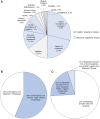Unstructured clinical documentation reflecting cognitive and behavioral dysfunction: toward an EHR-based phenotype for cognitive impairment
- PMID: 29947805
- PMCID: PMC6118865
- DOI: 10.1093/jamia/ocy070
Unstructured clinical documentation reflecting cognitive and behavioral dysfunction: toward an EHR-based phenotype for cognitive impairment
Abstract
Despite increased risk for negative outcomes, cognitive impairment (CI) is greatly under-detected during hospitalization. While automated EHR-based phenotypes have potential to improve recognition of CI, they are hindered by widespread under-diagnosis of underlying etiologies such as dementia-limiting the utility of more precise structured data elements. This study examined unstructured data on symptoms of CI in the acute-care EHRs of hip and stroke fracture patients with dementia from two hospitals. Clinician reviewers identified and classified unstructured EHR data using standardized criteria. Relevant narrative text was descriptively characterized and evaluated for key terminology. Most patient EHRs (90%) had narrative text reflecting cognitive and/or behavioral dysfunction common in CI that were reliably classified (κ 0.82). The majority of statements reflected vague descriptions of cognitive/behavioral dysfunction as opposed to diagnostic terminology. Findings from this preliminary derivation study suggest that clinicians use specific terminology in unstructured EHR fields to describe common symptoms of CI. This terminology can inform the design of EHR-based phenotypes for CI and merits further investigation in more diverse, robustly characterized samples.
Figures



Similar articles
-
Electronic Health Record Challenges, Workarounds, and Solutions Observed in Practices Integrating Behavioral Health and Primary Care.J Am Board Fam Med. 2015 Sep-Oct;28 Suppl 1(Suppl 1):S63-72. doi: 10.3122/jabfm.2015.S1.150133. J Am Board Fam Med. 2015. PMID: 26359473 Free PMC article.
-
Evaluation of an Algorithm for Identifying Ocular Conditions in Electronic Health Record Data.JAMA Ophthalmol. 2019 May 1;137(5):491-497. doi: 10.1001/jamaophthalmol.2018.7051. JAMA Ophthalmol. 2019. PMID: 30789656 Free PMC article.
-
Assessing the Availability of Data on Social and Behavioral Determinants in Structured and Unstructured Electronic Health Records: A Retrospective Analysis of a Multilevel Health Care System.JMIR Med Inform. 2019 Aug 2;7(3):e13802. doi: 10.2196/13802. JMIR Med Inform. 2019. PMID: 31376277 Free PMC article.
-
Automated tests for diagnosing and monitoring cognitive impairment: a diagnostic accuracy review.Health Technol Assess. 2016 Oct;20(77):1-74. doi: 10.3310/hta20770. Health Technol Assess. 2016. PMID: 27767932 Free PMC article. Review.
-
Screening for Cognitive Impairment in Older Adults: Updated Evidence Report and Systematic Review for the US Preventive Services Task Force.JAMA. 2020 Feb 25;323(8):764-785. doi: 10.1001/jama.2019.22258. JAMA. 2020. PMID: 32096857
Cited by
-
Mini-mental status examination phenotyping for Alzheimer's disease patients using both structured and narrative electronic health record features.J Am Med Inform Assoc. 2025 Jan 1;32(1):119-128. doi: 10.1093/jamia/ocae274. J Am Med Inform Assoc. 2025. PMID: 39520712
-
Mail and Telephone Outreach from Electronic Health Records for Research Participation on Cognitive Health and Aging.J Prev Alzheimers Dis. 2021;8(3):292-298. doi: 10.14283/jpad.2021.18. J Prev Alzheimers Dis. 2021. PMID: 34101786 Free PMC article.
-
Barriers to identifying residents with dementia for embedded pragmatic trials: A call to action.J Am Geriatr Soc. 2022 Feb;70(2):638-641. doi: 10.1111/jgs.17539. Epub 2021 Nov 2. J Am Geriatr Soc. 2022. PMID: 34727369 Free PMC article. Clinical Trial. No abstract available.
-
Future directions in ventilator-induced lung injury associated cognitive impairment: a new sight.Front Physiol. 2023 Dec 18;14:1308252. doi: 10.3389/fphys.2023.1308252. eCollection 2023. Front Physiol. 2023. PMID: 38164198 Free PMC article. Review.
-
Extracting Critical Information from Unstructured Clinicians' Notes Data to Identify Dementia Severity Using a Rule-Based Approach: Feasibility Study.JMIR Aging. 2024 Sep 24;7:e57926. doi: 10.2196/57926. JMIR Aging. 2024. PMID: 39316421 Free PMC article.
References
-
- de Lange E, Verhaak PF, van der Meer K.. Prevalence, presentation and prognosis of delirium in older people in the population, at home and in long term care: a review. Int J Geriatr Psychiatry 2013; 282: 127–34. - PubMed
-
- Laurila JV, Pitkala KH, Strandberg TE, Tilvis RS.. Detection and documentation of dementia and delirium in acute geriatric wards. Gen Hosp Psychiatry 2004; 261: 31–5. - PubMed
Publication types
MeSH terms
Grants and funding
LinkOut - more resources
Full Text Sources
Other Literature Sources
Medical

